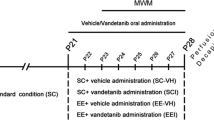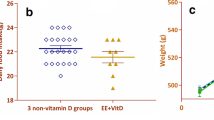Abstract
Postoperative cognitive dysfunction (POCD) is a significant clinical syndrome. Neurogenesis contributes to cognition. It is known that enriched environment (EE) enhances neurogenesis. We determined whether EE attenuated surgery-induced cognitive impairment and whether growth factors and neurogenesis played a role in the EE effect. Eight-week-old C57BL/6J mice were subjected to carotid artery exposure. Their learning and memory were assessed by Barnes maze, and fear conditioning started 2 weeks after the surgery. Growth factor expression and cell genesis were determined at various times after the surgery. Surgery increased the time for the mice to identify the target hole in the Barnes maze and reduced context-related freezing behavior. Surgery also reduced the expression of brain-derived neurotrophic factor (BDNF) and neurogenesis in the hippocampus. These effects were attenuated by EE. EE also attenuated surgery-induced reduction of phosphorylated/activated tropomyosin-related kinase B (TrkB) and extracellular signal-regulated kinases (ERK), components of BDNF signaling pathway. ANA-12, a selective TrkB antagonist, blocked the effects of EE on cognition, phosphorylation of TrkB and ERK, and neurogenesis. These results provide initial evidence that surgery reduces BDNF expression and neurogenesis in the hippocampus. Our results suggest that EE reduces surgery-induced impairment of learning, memory, and neurogenesis by preserving BDNF expression.









Similar content being viewed by others
References
Moller JT, Cluitmans P, Rasmussen LS et al (1998) Long-term postoperative cognitive dysfunction in the elderly ISPOCD1 study. ISPOCD investigators. International study of post-operative cognitive dysfunction. Lancet 351(9106):857–861
Monk TG, Weldon BC, Garvan CW et al (2008) Predictors of cognitive dysfunction after major noncardiac surgery. Anesthesiology 108(1):18–30
Newman MF, Kirchner JL, Phillips-Bute B et al (2001) Longitudinal assessment of neurocognitive function after coronary-artery bypass surgery. N Engl J Med 344(6):395–402
Steinmetz J, Christensen KB, Lund T et al (2009) Long-term consequences of postoperative cognitive dysfunction. Anesthesiology 110(3):548–555
Cibelli M, Fidalgo AR, Terrando N et al (2010) Role of interleukin-1beta in postoperative cognitive dysfunction. Ann Neurol 68(3):360–368
Cao L, Li L, Lin D et al (2012) Isoflurane induces learning impairment that is mediated by interleukin 1beta in rodents. PLoS ONE 7(12):e51431
Tang JX, Baranov D, Hammond M et al (2011) Human Alzheimer and inflammation biomarkers after anesthesia and surgery. Anesthesiology 115(4):727–732
Burger W, Chemnitius JM, Kneissl GD et al (2005) Low-dose aspirin for secondary cardiovascular prevention—cardiovascular risks after its perioperative withdrawal versus bleeding risks with its continuation—review and meta-analysis. J Intern Med 257(5):399–414
Douketis JD, Spyropoulos AC, Spencer FA et al (2012) Perioperative management of antithrombotic therapy: antithrombotic therapy and prevention of thrombosis, 9th ed: American college of chest physicians evidence-based clinical practice guidelines. Chest 141(2 Suppl):e326S–e350S
Birch AM, McGarry NB, Kelly AM (2013) Short-term environmental enrichment, in the absence of exercise, improves memory, and increases NGF concentration, early neuronal survival, and synaptogenesis in the dentate gyrus in a time-dependent manner. Hippocampus 23(6):437–450
Fares RP, Belmeguenai A, Sanchez PE et al (2013) Standardized environmental enrichment supports enhanced brain plasticity in healthy rats and prevents cognitive impairment in epileptic rats. PLoS ONE 8(1):e53888
Jurgens HA, Johnson RW (2012) Environmental enrichment attenuates hippocampal neuroinflammation and improves cognitive function during influenza infection. Brain Behav Immun 26(6):1006–1016
Briones TL, Woods J, Rogozinska M (2013) Decreased neuroinflammation and increased brain energy homeostasis following environmental enrichment after mild traumatic brain injury is associated with improvement in cognitive function. Acta Neuropathol Commun 1(1):57
Wang B, Jin K (2014) Current perspectives on the link between neuroinflammation and neurogenesis. Metab Brain Dis
van Praag H, Schinder AF, Christie BR et al (2002) Functional neurogenesis in the adult hippocampus. Nature 415(6875):1030–1034
Angelucci F, De Bartolo P, Gelfo F et al (2009) Increased concentrations of nerve growth factor and brain-derived neurotrophic factor in the rat cerebellum after exposure to environmental enrichment. Cerebellum 8(4):499–506
Kuzumaki N, Ikegami D, Tamura R et al (2011) Hippocampal epigenetic modification at the brain-derived neurotrophic factor gene induced by an enriched environment. Hippocampus 21(2):127–132
Waterhouse EG, An JJ, Orefice LL et al (2012) BDNF promotes differentiation and maturation of adult-born neurons through GABAergic transmission. J Neurosci 32(41):14318–14330
Cazorla M, Premont J, Mann A et al (2011) Identification of a low-molecular weight TrkB antagonist with anxiolytic and antidepressant activity in mice. J Clin Invest 121(5):1846–1857
Zhang J, Jiang W, Zuo Z (2014) Pyrrolidine dithiocarbamate attenuates surgery-induced neuroinflammation and cognitive dysfunction possibly via inhibition of nuclear factor kappaB. Neuroscience 261:1–10
Klein AB, Williamson R, Santini MA et al (2011) Blood BDNF concentrations reflect brain-tissue BDNF levels across species. Int J Neuropsychopharmacol 14(3):347–353
Wojtowicz JM, Kee N (2006) BrdU assay for neurogenesis in rodents. Nat Protoc 1(3):1399–1405
Binder DK, Scharfman HE (2004) Brain-derived neurotrophic factor. Growth Factors 22(3):123–131
Brown JP, Couillard-Despres S, Cooper-Kuhn CM et al (2003) Transient expression of doublecortin during adult neurogenesis. J Comp Neurol 467(1):1–10
Jacque CM, Vinner C, Kujas M et al (1978) Determination of glial fibrillary acidic protein (GFAP) in human brain tumors. J Neurol Sci 35(1):147–155
Bullwinkel J, Baron-Luhr B, Ludemann A et al (2006) Ki-67 protein is associated with ribosomal RNA transcription in quiescent and proliferating cells. J Cell Physiol 206(3):624–635
Jiang M, Peng Q, Liu X et al (2013) Small-molecule TrkB receptor agonists improve motor function and extend survival in a mouse model of Huntington’s disease. Hum Mol Genet 22(12):2462–2470
Aloe L, Properzi F, Probert L et al (1999) Learning abilities, NGF and BDNF brain levels in two lines of TNF-alpha transgenic mice, one characterized by neurological disorders, the other phenotypically normal. Brain Res 840(1–2):125–137
Lin D, Zuo Z (2011) Isoflurane induces hippocampal cell injury and cognitive impairments in adult rats. Neuropharmacology 61(8):1354–1359
Le Freche H, Brouillette J, Fernandez-Gomez FJ et al (2012) Tau phosphorylation and sevoflurane anesthesia: an association to postoperative cognitive impairment. Anesthesiology 116(4):779–787
Stratmann G, Sall JW, Bell JS et al (2010) Isoflurane does not affect brain cell death, hippocampal neurogenesis, or long-term neurocognitive outcome in aged rats. Anesthesiology 112(2):305–315
Grant Support
This study was supported by grants (R01 GM065211 and R01 GM098308 to Z Zuo) from the National Institutes of Health, Bethesda, MD, by a grant from the International Anesthesia Research Society (2007 Frontiers in Anesthesia Research Award to Z Zuo), Cleveland, OH, by a grant from Commonwealth of Virginia Alzheimer’s and Related Disease Research Fund, Richmond, VA, by a Grant-in-Aid from the American Heart Association Mid-Atlantic Affiliate (10GRNT3900019 to Z Zuo), Baltimore, MD, and the Robert M. Epstein Professorship endowment, University of Virginia, Charlottesville, VA.
Author Contributions
Z.Z. conceived the concept of the project. D.F. and Z.Z. designed research; D.F., J.L., B.Z., and L.H. performed research; D.F., J.L., B.Z., and Z.Z. analyzed data; and D.F. and Z.Z. wrote the paper.
Conflicts of Interest
None.
Author information
Authors and Affiliations
Corresponding author
Additional information
The research work was performed in the Department of Anesthesiology, University of Virginia, Charlottesville, VA 22908, USA.
Rights and permissions
About this article
Cite this article
Fan, D., Li, J., Zheng, B. et al. Enriched Environment Attenuates Surgery-Induced Impairment of Learning, Memory, and Neurogenesis Possibly by Preserving BDNF Expression. Mol Neurobiol 53, 344–354 (2016). https://doi.org/10.1007/s12035-014-9013-1
Received:
Accepted:
Published:
Issue Date:
DOI: https://doi.org/10.1007/s12035-014-9013-1




